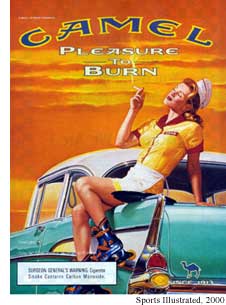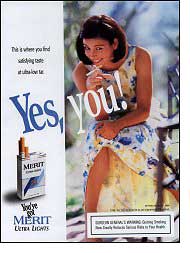
Despite an explicit ban on directing cigarette advertising at children, all three major U.S. tobacco companies
selectively increased youth targeting after the prohibition was put in place in 1998 report researchers from
the University of Chicago in the March/April issue of Health Affairs.
Tobacco companies exploited inconsistencies between the ban and the government's definition of youth
magazines in ways that enabled the industry to reach as many young readers as ever, the researchers found.
They propose that the best way to reduce the exposure of children to tobacco advertising is to ban such
ads from all magazines.
"What we found was a violation of the spirit and the letter of the 1998 settlement," said Paul Chung, M.D.,
a Robert Wood Johnson Clinical Scholar at the University of Chicago and co-first author of the paper. "Cigarette
companies had to become slightly more subtle about it, but they continue to aim their advertising at people under 18."
Tobacco companies "need to reach the youth market to survive," said co-first author Craig Garfield, M.D., also a Robert Wood Johnson Clinical Scholar at the University. Four out of five adult smokers began before age 18. About 28 percent of high school students now smoke..
Fearing thousands of separate, costly lawsuits from customers with smoke-related health problems, the major U.S. tobacco companies and 46 states signed the Master Settlement Agreement (MSA) on Nov. 23, 1998. The agreement shielded the manufacturers from future lawsuits in those states in exchange for a $250 billion payment. The MSA also placed restrictions on future tobacco advertising and cigarette sales practices.
The MSA expressly forbid tobacco companies from taking "any action, directly or indirectly, to target Youth within any Settling State in the advertising, promotion or marketing of Tobacco Products, or take any action the primary purpose of which is to initiate, maintain or increase the incidence of youth smoking."

The agreement neglected, however, to set clear limits on advertising in magazines that might reach young people or to establish a mechanism to detect efforts to target young readers.
Previous efforts to monitor youth targeting have focused on "youth magazines," defined by the Food and Drug Administration as those with more than 2 million readers under 18 (such as Sports Illustrated or People) or with greater than 15-percent young readers (such as Allure or Hot Rod). Earlier studies found that companies have continued to reach many young readers through these magazines, but could not prove that ad placements were specifically targeting young readers.
The Chicago researchers looked closer, tracking 12,000 cigarette ads placed at a cost of $1.01 billion in the 36 most widely read magazines from 1997 -- the year prior to the MSA -- through 2000. They analyzed the number and cost of ads purchased by each of the three biggest tobacco companies. Then they looked at how the ratio of ads placed in magazines with various levels of youth readership shifted over time.
They found that from 1997 to 2000 the number of cigarette advertisements in youth magazines fell 26 percent, largely because ad costs went up. Magazine advertising expenditures, however, increased by about 26 percent during this period.
More troubling, the researchers found that the tobacco companies had learned how to appear to comply with the MSA yet still reach young readers. The companies gradually reduced youth targeting in the closely monitored youth magazines. At the same time, they cut ads from magazines with few young readers.
They shifted their ads, instead, to magazines just under the FDA limits, as close as possible to the youth magazine threshold -- such as Glamour, where 1.9 million (or 14.7%) of its 12.7 million readers are 12 to 17 years old. The number of ads in these magazines increased by 14 percent in the two years after the MSA.

All three companies followed a similar pattern, although in slightly different ways. RJ Reynolds and Brown & Williamson concentrated their ads in magazines just under the 2 million cut off. From 1997 to 2000 they reduced by about 30 percent their efforts to target young readers through magazines above that limit and increased by about 60 percent youth targeting in magazines below the limit.
Over the same period, Phillip Morris focused on magazines just under the 15-percent young reader designation. They concentrated their advertising in magazines approaching that limit and avoided magazines with fewer than 10 percent young readers.
The arbitrary youth magazine definition "created an opportunity for tobacco advertisers to exploit youth readership differences below 2 million or 15 percent," note the authors. "Intentionally placing more ads in magazines with 1.5 million readers than in magazines with 1.0 million readers is clearly youth targeting," they argue, "and is banned by the MSA." They conclude that "youth targeting has not just persisted but has selectively increased."
"This finding reinforces the need to consider a ban against tobacco advertising in magazines like the bans in existence for TV, radio and billboards," added Garfield.
The time may be ripe. Although Brown and Williamson has maintained its magazine advertising, both Philip Morris and RJ Reynolds began to cut magazine spending in 2001, shifting their emphasis to direct mail, point-of-purchase displays and retail incentives.
"That's a step in the right direction," said Garfield, "but we suspect it's a temporary business decision, not a lasting moral stand. A legal ban would close this avenue for reaching kids forever."
This work was supported by grants from the Robert Wood Johnson Foundation. Additional authors of the paper include Paul Rathouz, Diane Lauderdale and John Lantos from the University of Chicago and Dana Best from Children's National Medical Center in Washington, DC.